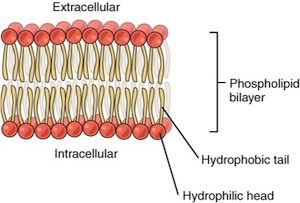Membrane Lipids
Introduction to Membrane Lipids
Membrane Lipids Overview
Membranes are dynamic structures that allow cells and subcellular structures to adjust their shape and change positions. Membranes are in a fluid state where proteins and lipids can diffuse and interact. Cellular membranes control the composition of the enclosed spaces by excluding various ions and molecules. They have selective transport systems for the transmembrane movement of substances. Extracellular regulators of cell function bind to protein receptors in the plasma membrane, generating signals to control metabolic pathways.
Amphipathic Nature of Membrane Lipids
Membrane lipids are amphipathic, meaning they display both polar and apolar characteristics with an affinity for both water (polar) and organic (apolar) solvents. Phosphoglycerides (glycerophospholipids), sphingolipids, and cholesterol are examples of amphipathic molecules.
Types of Membrane Lipids
Three major types of membrane lipids include:
- Glycerophospholipids - Backbone is glycerol 3-phosphate.
- Sphingolipids - The backbone is sphingosine.
- Cholesterol

Glycerophospholipids
Structure
Glycerophospholipids contain glycerol as their backbone. They are composed of:
- A phosphate group
- An alcohol such as choline, ethanolamine, serine, glycerol, or inositol
- A saturated fatty acid at C-1
- An unsaturated fatty acid at C-2
Common Types of Glycerophospholipids
- Phosphatidylcholine (PC)
- Phosphatidylethanolamine (PE)
- Phosphatidylserine (PS)
- Phosphatidylinositol (PI)
- Cardiolipin (CL)
Different head groups give these molecules unique properties and functions in the membrane.
Sphingolipids
Sphingolipids, having a sphingosine backbone, play significant roles, particularly in neural tissue membranes. Key sphingolipids include ceramides, sphingomyelins, cerebrosides, globosides, and gangliosides. Sphingomyelins contain phosphocholine as their head group, while cerebrosides and gangliosides contain carbohydrate moieties.
Cholesterol
Cholesterol is a compact, rigid, hydrophobic molecule consisting of four fused rings and a polar hydroxyl group at C-3. It plays a critical role in membrane fluidity and structure.
Cholesterol and Membrane Fluidity
At normal body temperatures, cholesterol increases membrane rigidity by filling spaces between phospholipids and sphingolipids, promoting tighter packing of these molecules.
Lipid Composition in Biological Membranes
The lipid composition varies across different cellular membranes, affecting membrane properties. For example, the plasma membrane is rich in cholesterol, while mitochondrial membranes have higher glycerophospholipid content.
Membrane Asymmetry
Membranes from living cells exhibit compositional asymmetry. Phosphatidylcholine, sphingomyelin, and glycolipids predominantly reside in the extracellular leaflet, while phosphatidylserine and phosphatidylethanolamine are mainly in the cytoplasmic leaflet.
Liposomes as Drug Carriers
Liposomes, formed from lipid bilayers, can encapsulate drugs, enzymes, or DNA, making them useful for targeted drug delivery.